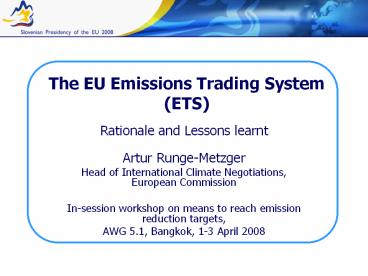The EU Emissions Trading System (ETS) PowerPoint PPT Presentation
1 / 10
Title: The EU Emissions Trading System (ETS)
1
The EU Emissions Trading System (ETS)
- Rationale and Lessons learnt
- Artur Runge-Metzger
- Head of International Climate Negotiations,
European Commission - In-session workshop on means to reach emission
reduction targets, - AWG 5.1, Bangkok, 1-3 April 2008
2
Building a global carbon market
- The carbon market cost-effective and flexible
mitigation tool and source of finance for low-GHG
technology development - EUs aim progressive development towards global
carbon market - Countries take part according to responsibilities
and capabilities - Backed by ambitious mitigation commitments in
line with 2 degree objective - Build on existing mechanisms, link schemes and
develop new mechanisms
3
Role of domestic emissions trading systems
- Directly engage private sector
- The EU has gained experience in setting up the
worlds largest company-based emissions trading
scheme EU ETS - Linking emissions trading schemes across the
world could help build the global carbon market - Key creating scarcity of tradable units
- Other key requirements transparency, liquidity,
long-term predictability and integrity
(monitoring, verification and compliance)
4
Why EU ETS?
- Market-based instrument which allows for most
cost-effective and targeted environmental policy-
no market intervention! - EU ETS is driver for carbon market valued at
around 40 billion globally (EU ETS 28 billion)
in 2007 - Cornerstone of Europes strategy to implement
Kyoto Protocol - major structural element for the
post-2012 climate strategy - EU ETS will contribute to reaching more than 40
of the EU15s Kyoto commitment 2008-2012 (i.e.
3.4pts of -8 below 1990)!
5
Staged introduction of the EU ETS
- 1st trading period
- Designed as a learning by doing phase
- Successful set up of necessary infrastructure
- Growing trade of allowances across Europe
- Thanks to experience gathered in 1st trading
period, companies and authorities are much better
prepared - 2nd trading period
- Commission assessment of allocation plans ensured
stringent cap and equal treatment of Member
States - On the basis of all plans, the approved cap is
6.5 below the 2005 verified emissions for the
ETS sector - The EU ETS will be successfully reducing
emissions in the trading sector - 3rd trading period aimed at reductions needed by
2020 (20-30)
6
Lessons learnt from EU ETS
- Get stakeholders involved early when setting up
ETS - Start with short pilot phase also to avoid
locking into over-allocation - Emissions trading needs stringent cap with
scarcity no oversupply - Need to have robust data to start with!
- Keep emissions trading simple
- Need for strong regulator to ensure environmental
integrity - Central cap setting, no more national allocation
plans - Auction large share of allowances is fairest
allocation method, ensure due auctioning process - Use revenues from auctioning for financing fight
against climate change - Ensure further harmonisation of monitoring,
reporting and verification, - Maximise transparency and legal certainty no
ex-post regulatory intervention - Keep use of offsets (CDM/JI) in balance to drive
investments in low carbon technologies at home
7
Prices and trade volume in the EU ETS
Jan 08 180m
Jan 08 180m
8
Review of the EU ETS enhancing financial flows
- EU Commission proposes auctioning as the
principle allocation method and that Member
States should use 20 of auctioning revenues for
mitigation and adaptation, inter alia - GHG reduction schemes, including GEEREF
- Adaptation to CC impacts, including in developing
countries - RD for emission reduction (e.g. RE and CCS) and
for adaptation - Measures to reduce emissions from deforestation
- Commission analysis of the proposal estimates
that revenues in the EU alone could increase to
about 75bn annually by 2020 with 100 auctioning
(at a price of 40 per ton CO2), even part of
this is potentially a large source of funding - Similar use envisaged for auctioning revenues
from aviation under the ETS, here 100 of
revenues
9
Conclusions
- Europe has turned the concept of market-based
climate policy into reality and a continent-wide
carbon price signal has emerged that has a
bearing on investments not only in the EU. - The EU ETS in its current shape is the first step
in an evolution to a global carbon market. The
ETS provides for valuable lessons learnt also
for other schemes worldwide. - The EU ETS will be even stronger and more
effective in its current (2008-2012) and third
phase (up to 2020). It can be a significant
source of financial flows. - The EU ETS is a key cornerstone of the broader EU
approach to energy security, innovation,
international competitiveness and its resolve to
move towards a low-carbon economy.
10
Thank you!

